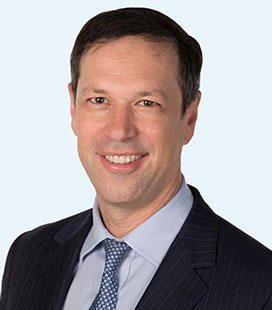
David Y. Feigenblum, MD, PhD, medical director of the implantable cardioverter defibrillator (ICD) center at Englewood Health
Englewood Health’s David Feigenblum, MD, PhD, a cardiac electrophysiologist (specialist in abnormalities of the heart’s electrical system), diagnoses and treats a range of heart rhythm disorders. Ventricular arrhythmias, which occur in the heart’s two lower chambers, or ventricles, can put patients at risk of sudden cardiac arrest and death.
When abnormal electrical signals in the ventricles cause the heart to beat too rapidly (tachycardia) or just quiver (fibrillation), an implantable cardioverter defibrillator (ICD) can save a person’s life.
To help us understand ICDs, Dr. Feigenblum explains…
ICDs and S-ICDs
Patients at risk of developing ventricular arrhythmias typically have a weak heart muscle due to:
- coronary artery disease
- prior heart attack
- heart infection
Others risk factors are a previous cardiac arrest, as well as certain genetic factors.
An ICD is an internal device that is implanted in the chest. When it detects a dangerously fast heartbeat, it delivers a small (or sometimes large) electrical shock to restore the normal heart rhythm. Its purpose is to prevent sudden cardiac death.
The two main types of ICDs are:
- Transvenous ICD—implanted with wire leads through the vascular system to the heart, it continuously monitors the heart’s rhythm and acts as both a pacemaker and a defibrillator.
- Subcutaneous ICD (S-ICD)—for patients with no condition requiring transvenous leads, this device uses an electrode near the heart to detect arrhythmias and deliver therapy. An S-ICD is often a good option for younger patients, such as those with a genetic heart condition, as it minimizes hardware and saves vascular space for any future interventions that may be needed.
Both types of ICDs are implanted through a minor surgical procedure in Englewood Health’s Electrophysiology Lab. Patients stay overnight in the hospital and go home the next day.
Quantity and Quality of Life
In electrophysiology, the focus is on quality, as well as quantity, of life. Generally, there are two things that patients want to know:
- Is it going to improve my quality of life?
- Is it going to extend my life?
For most patients, their biggest fear is how one lives life with a defibrillator. Their main questions concern what happens if the defibrillator detects that the heart needs to be “shocked” back into rhythm. Modern ICDs, which serve as both pacemaker and ICD, have two functions:
- Pacing therapy—this therapy is painless; the patient generally doesn’t feel anything.
- Shock therapy—the electrical shock, if needed to restore the heart’s rhythm, may last only a second. The shock, which can feel like a strong jolt, provides immediate therapy to treat a life-threatening arrhythmia. For patients who are awake when it occurs, it can be emotionally overwhelming, and our team is available to provide support.
Advances in Defibrillator Therapy
A study published in 2015 demonstrated the effectiveness of a new algorithm that has changed how electrophysiologists manage ICDs. In the past, patients were sometimes shocked unnecessarily. Today, the way we program the devices has significantly reduced unnecessary shocks to the heart; hence, when a patient is shocked, it is usually needed.
Few Restrictions for Patients with ICDs
We focus on quality of life for our patients. Essentially, patients have no restrictions after the initial recovery period. Patients often want to know if they can travel and might ask, “What if I am in Timbuktu?” I reassure them that the purpose of the defibrillator is to allow them to live a normal life, and I offer this analogy: It is as if you are walking around with your own ambulance crew. The device allows you to go about your life with the assurance that you are protected.
Remote Monitoring
We follow our patients through remote monitoring of their device. If a patient experiences a cardiac event, the system transmits the information from the defibrillator over a phone line. The data from their device goes to the “cloud,” and our team can log in to a secure site and see what is going on without the patient’s having to come in to the hospital’s emergency department. Since the device works globally, they can go to Timbuktu and still have continuity of care. We can follow them wherever they go.
Beyond Cardiac ICDs
At Englewood Health, we have a full-service and highly experienced electrophysiology team. In addition to pacemakers and ICDs, my partners and I implant resynchronization devices (also known as biventricular pacing) in advanced heart failure patients, to improve quality of life. We also routinely perform ablation procedures to treat atrial fibrillation and ventricular tachycardia, as well as a range of other cardiac EP tests and procedures.
Dr. Feigenblum’s Philosophy
As a physician, I see my role as that of an educator—educating my patients on their condition and options, and on how I, as an electrophysiologist, can help them have a better quality of life. I explain treatment options, so my patients, along with their family, can make their own decision. I try to treat every patient as a family member. I ask myself, if this were my mother, whom I love dearly, how would I treat this condition?
David Y. Feigenblum, MD, PhD, is medical director of the implantable cardioverter defibrillator (ICD) center at Englewood Health, and a member of the Englewood Health Physician Network. He practices at North Jersey Electrophysiology Associates and Northvale Cardiology. In addition to English, he is fluent in Hebrew.
Posted January 2019

David Y. Feigenblum, MD, PhD, medical director of the implantable cardioverter defibrillator (ICD) center at Englewood Health
